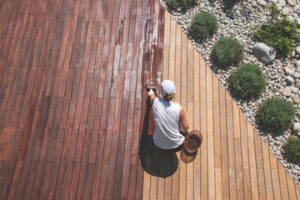Proper Deck Maintenance and Repair
When cleaning your deck, use a product specific to decks to prevent damage and discoloration. Be sure to rinse away any chemicals before they seep into nearby grass and flowers.

Avoid products that contain chlorine bleach, as they strip the natural color of your deck. Also, be careful not to use too much pressure on the boards, as this can cause them to warp or crack.
As with any surface, your deck needs a thorough cleaning at least twice a year. Doing so removes buildup and helps prevent mold and mildew. It also gives your deck a new look.
Start by sweeping away leaves, sticks, and other debris. Remove furniture and plants, if necessary, so you can get to the dirt underneath. Using a spray nozzle attached to your water hose, wash your deck with a biodegradable wood cleaning solution or nontoxic household cleaner. If you use a commercial cleaning product, follow the manufacturer’s instructions for dilution. Vinegar works well as a natural cleaner for composite decks, too, but be sure it’s safe for your specific type of material before applying it to the surface.
Allow your deck to dry thoroughly before using it again. This process can take two days or more, depending on how wet it is and the weather. It’s best to do a deeper clean during the spring or fall, when temperatures are milder.
Once your deck is completely dry, use a brush to remove any remaining bits of dirt and grit. Sand the decking if necessary to smooth it. You can also sand it to remove any flaking stains, but make sure you’re wearing a mask and eye protection. If your deck has a worn, uneven, or faded finish, you can reapply it. Just be sure to sand it again, and then apply the same or a slightly darker color to keep the finish from peeling.
If your deck has a plastic coating, reseal it annually to protect against the sun’s damaging UV rays. You can purchase plastic coatings that include a built-in mildew inhibitor at most hardware or general stores. It’s important to choose a semi-transparent sealant rather than one that’s solid or opaque, because solid and opaque products can cause your deck to look gray and dull.
You can also reseal your deck with an oil-based product. If you do, make sure the deck is completely dry before moving your furniture and resuming regular use of the area. Also, check the joists and support posts regularly for signs of rot.
Stain
Staining your deck gives it a facelift and helps protect it from water, sun damage, bugs, and wood rot. It’s important to stain a deck regularly, about every two to three years, depending on its location and use. But before you apply the new stain, remove any old stains. Leaving the old stain in place prevents the new stain from penetrating the surface of the wood and can create uneven color or even black spots on the deck.
Begin by sweeping the deck thoroughly and cleaning it with a special deck cleaner. If the old stain is peeling, use a sander or chemical deck stripper to remove it, following the manufacturer’s instructions. Then rinse the deck well to make sure there’s no residue left behind.
If you’re using a pressure washer to clean the deck, be careful not to oversaturate the wood and damage it. You may need to do a second rinse with clean water. Then let the deck dry completely.
You should also check to be sure the wood is porous, as this is crucial for staining. Do this by dropping a small amount of water on several different areas of the deck. If the water soaks in within eight minutes, the deck is ready for staining. If it doesn’t, the wood is likely milled, which doesn’t absorb stain as well.
It’s best to use a professional to restain your deck, especially if you have an older deck that needs a lot of work to look good again. The pros have the tools and experience to get the job done quickly and efficiently without damaging the wood.
While you’re waiting for your professional to arrive, prep the deck by removing any nails or screws that have popped out and repairing warped boards as needed. Clean up any grease spills and wash the deck again with a special deck cleaner.
Before you start staining, be sure to wear gloves, a mask, and a full-sleeve shirt to protect yourself from the chemicals in the deck stain. It’s a good idea to lay down a drop cloth or tarp under your stain pan and pad loading area, too, to catch any drips or splatter. You’ll want to choose a natural bristle brush if you’re using an oil-based stain or a roller with a nylon nap if you’re applying a water-based stain.
Seal
A sealer protects the wood from extreme heat and cold, snow, and moisture. It also helps keep dirt from penetrating the surface and causing damage. Staining and sealing are important for all decks, but especially those in northern climates where the freeze-thaw cycle often leads to moisture damage.
Before you seal, inspect the deck for any loose or sagging boards and secure them tightly. Check that any nails or screws protruding from the surface are driven below the wood, and replace any that are rusted or damaged. Also check stair railings and handrails for looseness, and tighten or replace any that are loose. This is a good opportunity to address any other maintenance issues that you have been putting off, such as replacing squeaky board ends.
Washing the deck before staining is vital. This removes any remaining dust and dirt that would otherwise interfere with the absorption of the new sealant. Also, you may want to lightly sand the deck with a pole sander to improve its appearance and encourage deep penetration of the stain. Again, make sure to wipe away all sanding dust thoroughly.
While you’re cleaning and sanding, be sure to protect any nearby plants and decorations with plastic and painter’s tape. Deck sealants and stains are toxic to plants, and any drips can prevent the plant from absorbing the nutrients it needs.
Choose a day for staining when the weather is warm and dry, if possible. A hot afternoon sun can cause the sealant to evaporate too quickly, preventing it from fully protecting the deck.
Follow the manufacturer’s instructions for staining and sealing. Be sure to allow the deck to dry for the number of days recommended by the product before walking on it again. Also, be sure to rinse the deck thoroughly afterward with lots of fresh water. Any remaining residue can prevent the wood from absorbing and soaking in the sealant, and it can also be harmful to people and pets.
Repair
A wood deck can be a great addition to your home, but it can also be a source of moisture problems. Over time, a deck can be damaged by water and sun exposure, creating a breeding ground for mold and rot. Proper maintenance and routine repairs can protect your deck from the elements and extend its life.
Start with a thorough inspection. Look for missing boards and warped or cracked surfaces. If the damage is limited to surface areas, you can often fix them yourself. However, if a board is loose or sagging, it can create a safety hazard and may require professional attention.
If you notice a section of the deck that has soft or darkened timber, it is likely suffering from rot. If the rot is confined to surface areas, you can usually replace the affected deck boards with new ones. If the rot extends to joists or other structural members, you will probably need to bring in a professional for a more extensive repair.
Check that the joists and beams are in good condition, especially in areas where the deck is close to ground level or vegetation. If a portion of a joist is compromised, it will need to be joined with a piece of solid material. A professional handyman can perform this job, but it is a more complex repair than simply replacing a board.
Make sure that gutters and downspouts are free of debris and that they are working properly. If leaves or yard debris pile up on a deck, they can block sunlight and trap moisture, which will lead to mold and rot. Remove any plants or furniture from the deck periodically to allow air to circulate and prevent moisture buildup.
A dust mask can be helpful when sanding the deck, but you can also sand by hand with 50-grit paper, making sure to always sand with the grain. After sanding, test the surface for moisture by pouring a capful of water on several different areas of the deck. The water should soak into the deck surface within a minute. If the water beads up, you will need to strip and sand those areas again, then redo the test.





